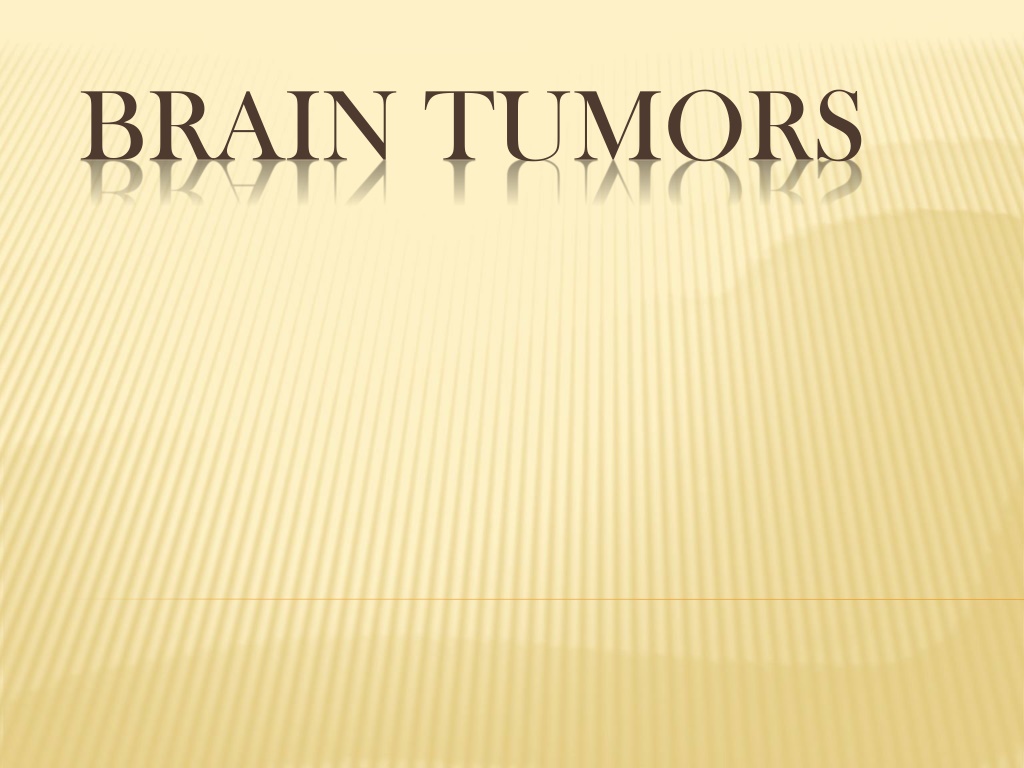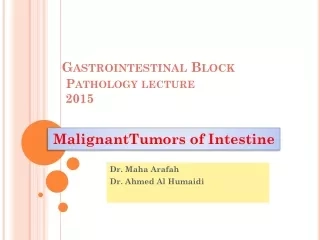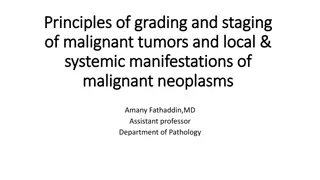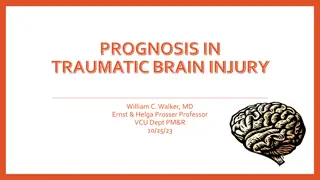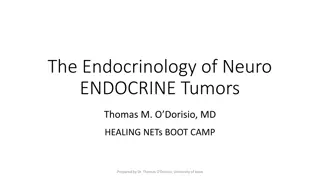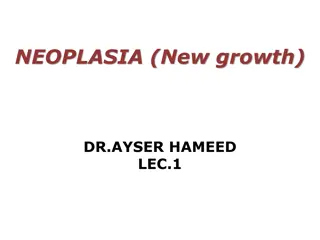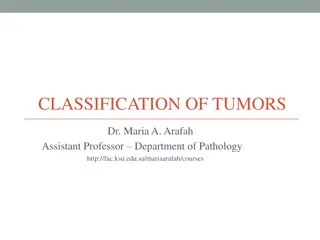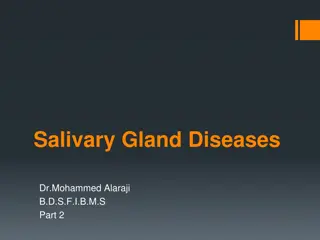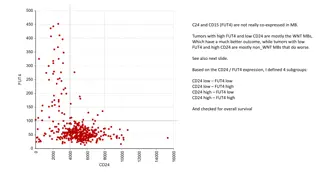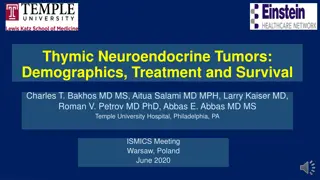Understanding Brain Tumors: Classification, Clinical Features & Prognosis
Brain tumors, whether primary or secondary, present with various clinical features such as neurological deficits, seizures, and raised intracranial pressure. The classification includes common types like gliomas, meningiomas, and medulloblastomas. Astrocytomas are the most common primary intracranial neoplasms, with varying grades and prognosis. Oligodendrogliomas and ependymomas also have distinct characteristics, while medulloblastomas primarily affect the cerebellum in children. Recognizing symptoms and understanding tumor types are crucial for timely diagnosis and management.
Download Presentation

Please find below an Image/Link to download the presentation.
The content on the website is provided AS IS for your information and personal use only. It may not be sold, licensed, or shared on other websites without obtaining consent from the author. Download presentation by click this link. If you encounter any issues during the download, it is possible that the publisher has removed the file from their server.
E N D
Presentation Transcript
CLASSIFICATION OF BRAIN TUMOR Primary : 1-Gliomas (most common primary brain tumor) 50% Astrocytomas Oligodendrogliomas Ependymomas 2-Meningioma. 25% 3-.Schwanomas. 10% 4-Medulloblastoma. 5-Pitutary adenoma. 6-CNS lymphoma. Secondary metastasis: most common brain tumor.
CLINICAL FEATURES OF BRAIN TUMOR Brain tumors usually present with one of three syndromes: (1) Subacute progression of a focal neurologic deficit; result from compression of neurons and white matter tracts by expanding tumor and surrounding edema. (2) Seizure; may result from disruption of cortical circuits by a tumors that invade or compress the cerebral cortex(e.g meningiomas) (3) Raised intracranial pressure Other presentations may include: Sudden stroke like onset of focal neurological deficit which may result from hemorrhage inside the tumor . Systemic symptoms such as fever, malaise, weight loss or anorexia which usually suggest a metastatic rather than a primary brain tumor.
CLINICAL FEATURES OF RAISED INTRACRANIAL PRESSURE 1) Headache 4) Papilledema 2) Nausea and Vomiting 5) False localizing signs 3) Depression of conscious level 6) Signs of tentorial herniation and coning. The headaches of raised intracranial pressure is characterized by : Not extremely severe, and usually generalized throughout the head. Worse with recumbancy. Worse by coughing, straining and bending. Intermittent, typically develop rapidly over minutes, persist for 20-30 minutes and subside quickly. They tend to be worse in the mornings, sometimes wake the patient earlier than his normal waking time.
ASTROCYTOMAS : ASTROCYTOMAS : ARE THE MOST COMMON PRIMARY INTRACRANIAL NEOPLASMS. Low grade Low grade (grade I and grade II ) (grade I and grade II ) High grade High grade grade III and grade IV grade III and grade IV (GBM) (GBM) Typically benign Highly malignant Occur commonly in childhood Occur in adult Usually in the cerebellum Often supratentorial Well demarcated No clear margin between the tumor and normal brain tissue Excellent prognosis after surgical excision Poor prognosis
Oligodendrogliomas : Oligodendrogliomas : Commonly occur in adult ,have a more benign coarse than astrocytomas .occur chiefly in a supratentorial locations and in 30% contains areas of calcifications. Ependymomas : Ependymomas : In adult it commonly affect the lower spinal cord, but could be occur in higher levels or intracranialy.It relatively well demarcated from adjacent brain tissue, and has a good prognosis following total resection. Medulloblastomas: Medulloblastomas: Highly malignant tumor occur in the posterior fossa , along with astrocytomas are the most frequent malignant brain tumor occur in children .
Meningiomas: Meningiomas: These tumors are usually benign and attached to the dura. Most often occur along the sagittal sinus, over the cerebral convexities and in the cerebellar-pontine angle. They are more frequent in women than men, with a peak incidence in middle age. these tumors grow slowly and rarely become symptomatic. Total surgical resection is curative
Schwannomas Schwannomas This tumor is usually benign and arise from Schwann cells of nerve roots, most frequently in the eighth cranial nerve (vestibular schwannoma, formerly termed acoustic neuroma) .The fifth cranial nerve is the second most frequent site. Patients with vestibular schwannomas characteristically present with progressive unilateral hearing loss. As the tumor grows, it can compress the cerebellum, pons, or facial nerve. Whenever possible, schwannomas should be surgically excised. When the tumors are small, it is usually possible to preserve hearing in the involved ear. In the case of large tumors, the patient is usually deaf at presentation; nonetheless, surgery is indicated to prevent further compression of posterior fossa structures.
CEREBRAL METASTASES CEREBRAL METASTASES Cerebral metastases are the most common type of brain tumor in adults. One third of metastases are discovered before the diagnosis of primary tumor. The most common sources of intracranial metastases are: Lung Breast GI tracts Skin (melanoma) Leukemia. Most metastases arrive via the blood stream and commonly lodge at the gray white matter junction, particularly in watershed areas between the middle and postrior cerebral arteries .
INVESTIGATIONS Neuroimaging CT and MRI can reveal mass effect and contrast enhancement. Mass effect: reflects the volume of neoplastic tissue as well as surrounding edema. Contrast enhancement: reflects a breakdown of the blood-brain barrier within the tumor, permitting leakage of contrast agent. CT is cheaper, more widely available and (when used with contrast enhancement) capable of detecting the majority of tumors. MR scanning is superior in many ways, especially in detecting small tumors and tumors in the base of the skull and the posterior fossa. Other tests radiological and other imaging techniques elsewhere in the body if metastatic disease seems likely; hematological and biochemical investigation if cerebral abscess, granuloma, metastatic disease or pituitary pathology are under consideration.
TREATMENT (1)Medical Treatment Glucocorticoids decrease the volume of edema surrounding brain tumors and improve neurologic function; dexamethasone (initially 12 20 mg/d in divided doses PO or IV) is used, the dose is rapidly tapered to the lowest dose that relieves symptoms. The treatment of epilepsy associated with brain tumors is identical to the treatment of other forms of partial epilepsy. The first-line agents phenytoin, carbamazepine, and valproic acid are equally effective
(2)SURGICAL TREATMENT Complete removal Meningiomas, pituitary tumours, acoustic neuromas and some solitary metastases in accessible regions of the brain can all be removed completely. Partial removal Gliomas in the frontal, occipital and temporal poles may be removed by fairly radical debulking operations. Sometimes, benign tumours cannot be removed in their entirety because of tumour position or patient frailty. Biopsy If at all possible, the histological nature of any mass lesion in the brain should be established. What looks like a glioma or metastasis from the clinical and radiological points of view occasionally turns out to be an abscess or a benign tumour.If the mass lesion is not in a part of the brain where partial removal can be attempted, biopsy by means of a needle through a burrhole usually establishes the histological diagnosis.
Shunting Midline tumours causing ventricular dilatation are routinely treated by the insertion of a shunt into the dilated ventricular system. This returns intracranial pressure to normal, and may completely relieve the patient s symptoms.
(3)Radiotherapy Middle-grade gliomas, metastases and incompletely removed pituitary adenomas are the common intracranial tumours which are radiosensitive. The posterior fossa malignant tumours of childhood and lymphoma are also sensitive to radiotherapy. Radiotherapy commonly follows partial removal or biopsy of such lesions, and continues over a few weeks whilst the preoperative dose of dexamethasone is being gradually reduced. (4)Chemotherapy Chemotherapy can be useful as primary treatment for lymphoma and as adjunctive therapy for oligodendroglioma astrocytomas. and some high-grade
NEUROCUTANEOUS DISORDERS
Neurofibromatosis Type 1 (Von Recklinghausen's Disease) cutaneous neurofibromas, pigmented lesions of the skin called caf au lait spots, freckling in non-sun-exposed areas such as the axilla, hamartomas of the iris termed Lisch nodules. Neurofibromas are benign peripheral nerve tumors. They present as multiple, palpable, rubbery, cutaneous tumors. They are generally asymptomatic. Patients with NF1 are at increased risk of developing nervous system neoplasms Neurofibromatosis Type 2 NF2 is characterized by the development of bilateral vestibular schwannomas in >90% of individuals who inherit the gene. Patients with NF2 also have a predisposition for the development of meningiomas, gliomas, and schwannomas of cranial and spinal nerves
Tuberous Sclerosis (Bourneville's Disease) Tuberous sclerosis is characterized by: Cutaneous lesions. Seizures (infantile spasms). Mental retardation. The cutaneous lesions include: Facial angiofibromas( Adenoma sebaceum). Ash leaf shaped hypopigmented macules. Shagreen patches (yellowish thickenings of the skin over the lumbosacral region of the back). Depigmented nevi. Tuberous sclerosis patients are at increased risk of developing ependymomas and childhood astrocytomas.
